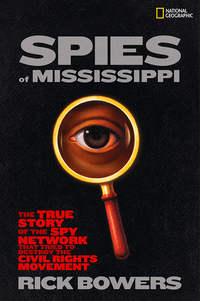
Полная версия
National Geographic Kids Chapters: Tiger in Trouble!: and More True Stories of Amazing Animal Rescues


Copyright © 2012 National Geographic Society
All rights reserved. Reproduction of the whole or any part of the contents without written permission from the publisher is prohibited.
Published by the National Geographic Society
John M. Fahey, Jr., Chairman of the Board and Chief Executive Officer
Timothy T. Kelly, President
Declan Moore, Executive Vice President; President, Publishing and Digital Media
Melina Gerosa Bellows, Executive Vice President; Chief Creative Officer, Books, Kids, and Family
Prepared by the Book Division
Hector Sierra, Senior Vice President and General Manager
Nancy Laties Feresten, Senior Vice President, Editor in Chief, Children’s Books
Jonathan Halling, Design Director, Books and Children’s Publishing
Jay Sumner, Director of Photography, Children’s Publishing
Jennifer Emmett, Editorial Director, Children’s Books
Eva Absher-Schantz, Managing Art Director, Children’s Books
Carl Mehler, Director of Maps
R. Gary Colbert, Production Director
Jennifer A. Thornton, Director of Managing Editorial
Staff for This Book
Becky Baines and Laura F. Marsh, Project Editors
Lori Epstein, Illustrations Editor
Eva Absher-Schantz, Art Director
YAY! Design, Designer
Grace Hill, Associate Managing Editor
Joan Gossett, Production Editor
Lewis R. Bassford, Production Manager
Susan Borke, Legal and Business Affairs
Kate Olesin, Assistant Editor
Kathryn Robbins, Design Production Assistant
Hillary Moloney, Illustrations Assistant
Manufacturing and Quality Management
Phillip L. Schlosser, Senior Vice President
Chris Brown, Vice President, NG Book Manufacturing
George Bounelis, Vice President, Production Services
Nicole Elliott, Manager
Rachel Faulise, Manager
Robert L. Barr, Manager

For more information, please call
1-800-NGS LINE (647-5463) or
write to the following address:
National Geographic Society
1145 17th Street N.W.
Washington, D.C. 20036-4688 U.S.A.
Visit us online at nationalgeographic.com/books
For librarians and teachers: ngchildrensbooks.org
More for kids from National Geographic: kids.nationalgeographic.com
For rights or permissions inquiries, please contact National Geographic Books Subsidiary Rights: ngbookrights@ngs.org
eISBN: 978-1-4263-1080-5
v3.1
Version: 2017-07-07
Table of CONTENTS
Cover
Title Page
Copyright
NITRO: Tiger in Trouble
Chapter 1: Junkyard Jungle
Chapter 2: To the Rescue
Chapter 3: Nitro’s New Life
ETHEREAL: An Albino Bat Baby
Chapter 1: Lost and Found
Chapter 2: Food and Friendship
Chapter 3: Life in a New Home
SUZIE, BOB, & CALEB: The Three Monkeyteers
Chapter 1: Escape from Tiny Cages
Chapter 2: The Healing Begins
Chapter 3: A New Kind of Family
DON’T MISS!
Dedication
Credits
Acknowledgments
NITRO: TIGER IN TROUBLE
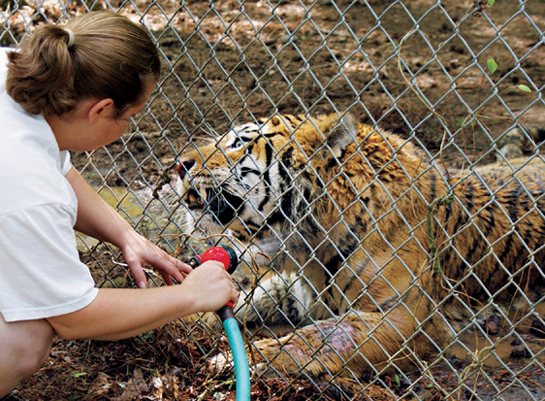
Nitro, a 600-pound tiger, is cared for by Carolina Tiger Rescue. (illustration credit p01)
Chapter 1 Junkyard JUNGLE
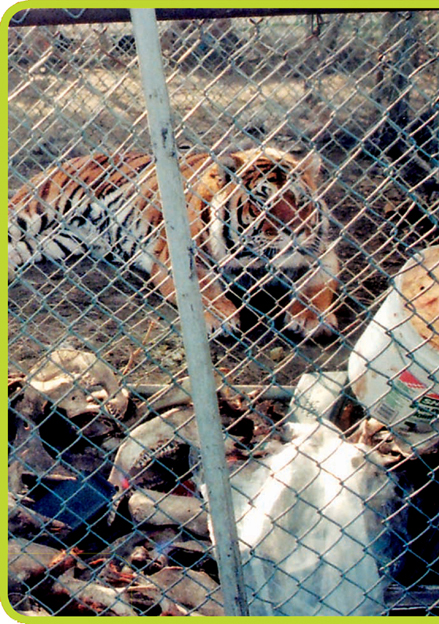
Nitro’s Kansas home was a tiny cage in a junkyard. (illustration credit 1.1)
Ten-year-old Nitro paced in his cage. It was the evening of February 21, 2009. The sun was setting quickly. Nitro’s owner, Jeffrey Harsh, was late with the tiger’s dinner.
Hungry big cats get restless, but Nitro couldn’t pace far. His chain-link cage was only 20 feet wide and 30 feet long—one-third the size of a school gym. Nitro was eight feet long. He could only take a few steps. Then he had to turn and walk the other way. Back and forth. Back and forth.
He stepped over bones in the dust. They were left over from earlier meals. He brushed against Apache, the other tiger in his cage. His empty belly grumbled. He growled and roared.
Nitro and Apache were not alone. There were three female lions in other cages nearby. All of these big cats were living at the Prairie Cat Animal Refuge near Oakley, Kansas—and they were all hungry.
A man wandered to the main gate. The cats’ eyes locked on him. He opened the gate and slowly came inside.
The man passed piles of junk. He looked into each animal’s cage. Nitro listened, while the other cats studied the stranger.
Then the man walked toward a lioness. He slipped his hand inside the metal bars of her gate.
It was a very bad choice.
To the hungry lion, his arm looked like dinner. Her instinct told her to catch her meal, and she listened. She bit down on the stranger’s arm. He screamed and screamed.
Just then Jeffrey drove up with a truck full of meat. He could tell right away things were not right. The entry gate was unlocked and open. Screams were coming from the big cats’ cages. Jeffrey jumped out of his truck and ran toward the sound.
Jeffrey saw the stranger. He ran past Nitro, toward the lion cage. Jeffrey grabbed the man and tried to pull him free. But he wasn’t as strong as the lion, and she would not let go. He never hit the animals, but he didn’t know what else to do. The man was in serious danger.
Jeffrey picked up a metal pipe and swung at the lioness. At last, she opened her jaws, and the frightened man fell back. Jeffrey rushed the stranger to the hospital. As he drove, he called the police on his cell phone.
Nitro would have to wait a little longer for his dinner. His owner was under arrest. He had not protected the stranger from the dangerous big cats.
Until that night, Jeffrey Harsh had broken no laws. Almost half of the states in the U.S. have passed laws to make it illegal to own wild animals like Nitro. Thirteen other states have some rules that say who can keep them and who cannot. The rest of the states have almost no laws at all. There, almost anyone can buy a wild animal.
Kansas is one of the 13 states with some rules. But the rules are not strong enough, said Sheriff Rod Taylor, the officer who arrested Jeffrey. Owners do not even need to take a class to learn how to care for a wild animal. If people like Jeffrey Harsh follow a few rules, they can buy big cats and raise them. And terrible things can happen.
Jeffrey didn’t see it that way. He didn’t think his big cats would hurt anyone. He thought since his animals were raised in captivity, or in cages, they would not act like wild animals.
“They were born in captivity,” he said on his website, “and bottle fed, so they think they are human. They are as gentle and sweet as a house cat.” He was wrong.
The judge gave Jeffrey a choice. He could pay fines and spend months in jail, or he could give the big cats to people who knew how to take care of them. Jeffrey decided to give his pets away. The lionesses were headed to the Detroit Zoo. But this zoo didn’t need any tigers. No zoo did.


(illustration credit 1.2)
So You Think You Want a Baby Tiger?
Keeping a baby tiger as a pet might seem like a great idea. At first, they weigh only a few pounds. And they don’t have teeth. They are cute and harmless.
But as they grow bigger and stronger, tigers play rough. They can hurt their owners. It is better to visit a tiger in a zoo or animal rescue. They don’t belong in people’s homes.
So where would Nitro and Apache go?
Sheriff Taylor called animal rescue experts for help. They told him about Carolina Tiger Rescue in North Carolina. Would they agree to take Nitro and Apache? That was the big question.
Kathryn Bertok works at Carolina Tiger Rescue. She takes care of the animals that live there.
“We won’t take an animal unless we can take them for the rest of their lives,” Kathryn explained. That’s because moving a tiger is hard. It is hard for the tiger. It is also hard for the people moving it.
Tigers that are cared for by humans can live to be 20 years old. Nitro and Apache were 10 years old. Tiger Rescue would have to pay the cost of feeding and caring for two tigers for ten more years. Could they afford it?
There was another important question: How much space would Nitro and Apache need? Big cats get sad in small spaces. They pace in a figure-eight pattern. They pant and grumble. They even suck their tails, like a baby human sucks its thumb.
The tiny cage in Kansas was far too small for two full-grown cats. A new home for Nitro and Apache would need to be bigger. Much bigger. It would take a space 37 times as big as their Kansas cage to keep them happy.
Experts at Carolina Tiger Rescue thought long and hard.
At last, they answered yes.
Chapter 2 To the RESCUE
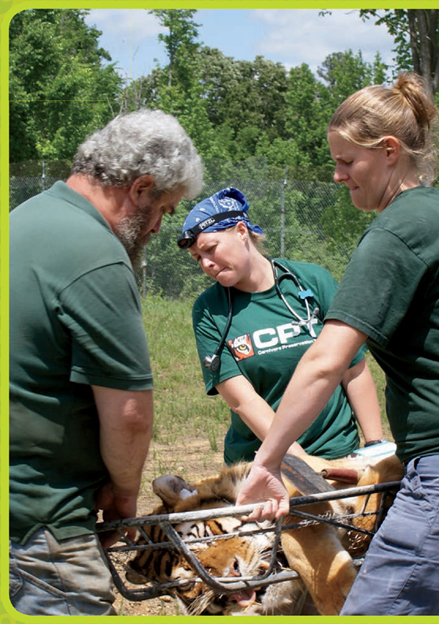
The experts at Carolina Tiger Rescue know how to care for and move big cats. (illustration credit 2.1)
Moving Nitro and Apache from Kansas to North Carolina would be a tiger-size challenge. Even so, Kathryn was sure she could do it.
Kathryn loaded the Rescue’s truck. She put in two large crates—one for Nitro and one for Apache. She also took along tools and fence cutters. The tiger cubs had grown large in their little chain-link cage. They were now too big to get in and out through the door. Kathryn might have to cut the cage apart.
On April 12, 2009, Kathryn arrived in Oakley, Kansas. She had been driving for 26 hours. She checked into a hotel and got ready for a good night’s sleep. Saving two tigers would not be easy. Kathryn would need all her strength and energy.
Kathryn, Sheriff Taylor, and an animal doctor called a veterinarian (vet) met at the front gate of the Prairie Cat Animal Refuge. Nitro was awake. He heard new voices and smelled unfamiliar scents. The strangers made him feel uneasy. He paced and softly grumbled.
Kathryn could tell that the tigers were calm. But they did not seem to trust her. “Animals can sense when something big is about to happen,” she said.
It was time for Nitro and Apache to take a nap. The vet had a special dart gun to shoot medicine into the tigers. If the darts hit just right, Nitro and Apache would be fast asleep in no time. They would sleep while the team moved them. Then they would wake up safe and sound inside their travel crates. The vet knew just the right amount of medicine to use.
POP. POP. The vet pulled the trigger, and the darts hit their targets.
Nitro hissed quietly when the dart hit his shoulder. His ears fell flat against his head. He was afraid. Then he felt the medicine start to work. He settled down. His stomach was flat on the dusty earth. His breathing slowed down. He fell into a deep and peaceful sleep.
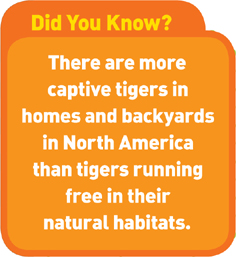
Quickly, Kathryn cut a large hole in the chain-link fence. She and the others climbed through the hole into the cage. Gently, they loaded Nitro into a large travel crate. It looked like a crate for a very large dog.
Nitro woke a short time later. He was safely loaded into the Carolina Tiger Rescue truck. Kathryn drove east, out of Kansas. Nitro was slightly confused, but not afraid.
“It depends on the animal,” Kathryn said. “But these guys were fine. When you get on the road, they tend to settle down, like kids. The movement of the truck relaxes them.”
Every two hours, Nitro saw his new caretakers. They stopped to check on him and give him food or water. Twenty-six hours later, Nitro was at the rescue. But it would still be another month before he could move into his forever home.
The concrete cells where Nitro and Apache first stayed weren’t very comfortable. The hard surface felt strange against Nitro’s paws. But the cells were clean and safe.
The people at the rescue needed to keep Nitro and Apache separated. They could not be near the other cats for 30 days. During that time, the tigers would get a full medical checkup by the veterinarians.
If they had any diseases, the vets could find out before they passed it on to other tigers. They would also check Nitro and Apache for injuries and give them medicine if they needed it. Only after that could the tigers be around other animals.
The veterinarian put Nitro to sleep again. This time, it was a much deeper sleep because the vet had a lot to do. Nitro needed his teeth cleaned. He had to get shots. And he needed to have a tiny microchip placed just under his skin. Then he could be tracked and returned to Carolina Tiger Rescue if he was ever lost or stolen.
Конец ознакомительного фрагмента.
Текст предоставлен ООО «ЛитРес».
Прочитайте эту книгу целиком, купив полную легальную версию на ЛитРес.
Безопасно оплатить книгу можно банковской картой Visa, MasterCard, Maestro, со счета мобильного телефона, с платежного терминала, в салоне МТС или Связной, через PayPal, WebMoney, Яндекс.Деньги, QIWI Кошелек, бонусными картами или другим удобным Вам способом.






